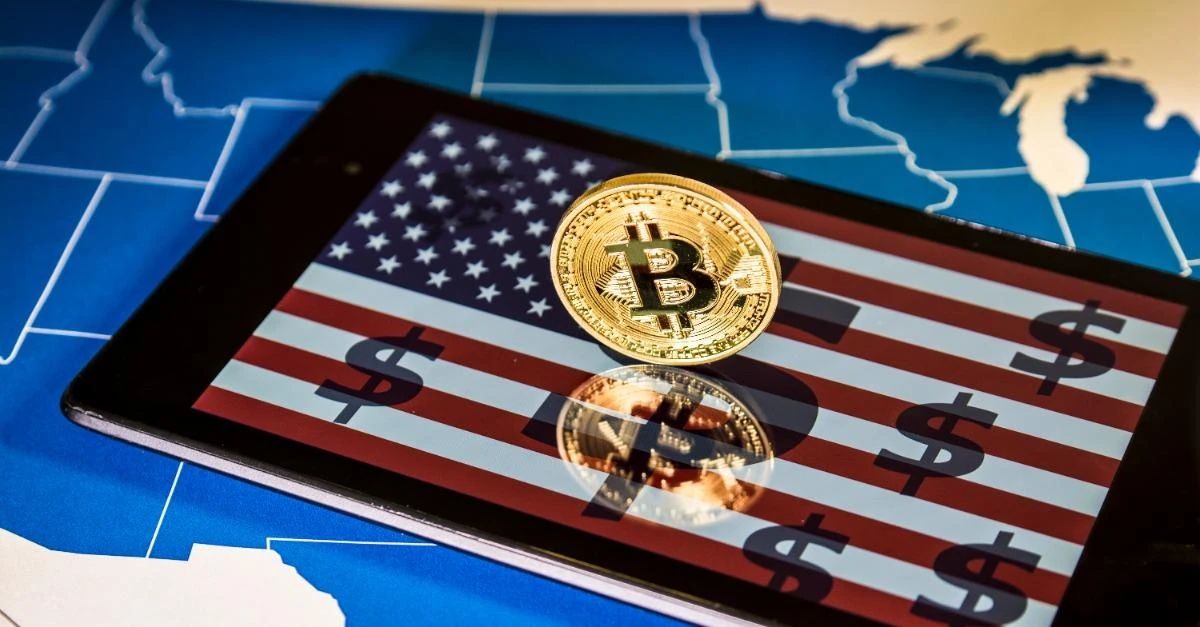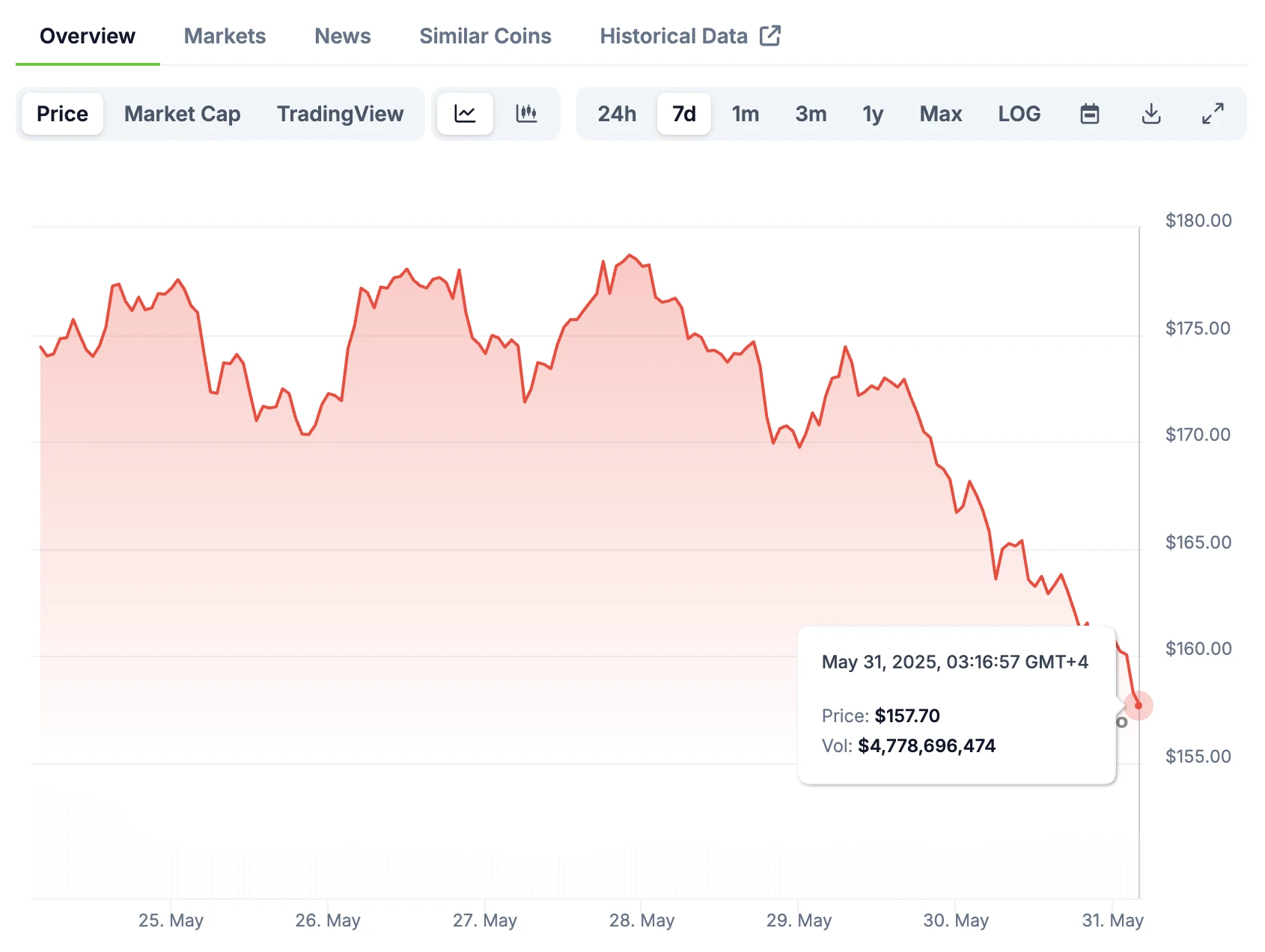Original | Odaily Planet Daily ( @OdailyChina )
Author: jk

On May 30, as Trump claimed that there might be a new round of tariff measures, the overall crypto market went down, BTC once fell below $104,000, and mainstream currencies generally fell. Investor sentiment tended to be cautious, and the market lacked a clear catalyst for rising in the short term.
Mainstream currencies generally pull back
According to Coingecko data, BTC is quoted at $104,028, down 1.7% in the past 24 hours, and the decline widened to 3.8% in 7 days, with the market value falling back to $2.07 trillion. Although the trading volume remains at a high of $39.3 billion, the price trend is still under pressure. ETHs decline is more obvious, falling 4% in 24 hours, currently quoted at $2,520, and the market value has dropped to $306.8 billion.

Solanas decline was concentrated in the past two days. Source: Coingecko
SOL became the mainstream asset with the largest correction, with a 24-hour drop of 5.4% and a weekly drop of 10.7%. It is now trading at $157, falling below the $160 mark. BNB is relatively resistant to declines, but it also recorded a 2.5% intraday drop and is now trading at $662. XRP is trading at $2.16, down 4.7% in 24 hours and 7.3% in the week.
Dogecoin (DOGE) has become one of the weakest currencies in this round of correction, falling 9.8% on the day and 15.1% on the week, now at $0.1961. Although the community is still enthusiastic, there are obvious signs of capital outflow. In the absence of major positive factors or fundamental support, the crypto market faces certain repair pressure in the short term. At present, funds tend to be risk-averse, and more flows to stablecoins or temporarily leave the market to wait and see.
Reason analysis: Tariff policy fluctuations trigger risk aversion, and the market is under short-term pressure
The Trump administration has taken many tariff measures recently. Here is a summary based on the timeline:
May 29:
The U.S. Court of International Trade ruled that most of the Trump administrations global tariff policies were illegal , and determined that the International Emergency Economic Powers Act (IEEPA) cited by the Trump administration did not authorize the president to impose tariffs on almost all imported goods. The court emphasized that according to the Constitution, trade policy should be led by Congress rather than unilaterally decided by the president. The White House immediately appealed and accused judicial intervention of hindering its economic diplomacy strategy, and trade policy uncertainty has increased significantly.
May 30:
The federal appeals court urgently ruled to suspend the lower courts ruling, allowing the Trump administration to continue to implement tariffs during the litigation. (Although most tariffs have been suspended under the agreement at this time) This reversal has exacerbated market concerns about policy reversals and enforcement, and funds have shown signs of outflows, turning to stablecoins and US dollar assets. A White House spokesman publicly stated that court intervention is undermining the United States bargaining chips in trade negotiations and criticized the judge for excessive overreach.
Subsequently, the direct cause of the market decline was that Trump once again posted on Truth Social, accusing China of serious violations of the mutual tariff exemption agreement on minerals reached in Geneva in the middle of this month. He said that in order to avoid the deterioration of the situation in China, he had made a brief concession to suspend punitive tariffs of up to 145%, but would consider re-applying pressure. This statement once again released a signal of trade tension, and the market was worried about the escalation of a new round of conflict between China and the United States. Against the backdrop of rising risk aversion, the crypto market became one of the main directions for capital withdrawal, and mainstream currencies generally fell during the day.
Trumps negotiating style? Or is a tariff war really coming?
Trumps negotiating style is consistently characterized by extreme pressure and strategic repetition, that is, gaining negotiation advantage through high-profile threats and creating uncertainty. This strategy is common in his trade negotiations with China and Europe.
Previously, similar strategies have also appeared in the US-EU trade relationship. After most of the tariffs were settled, Trump threatened to impose a 50% tariff on EU goods from June 1, and then postponed the implementation date to July 9 after a call with European Commission President von der Leyen. The EU welcomed this and expressed its willingness to speed up the negotiation process.
This cycle of high pressure-easing-re-pressure has given the market the impression that Trumps negotiation strategy is Trump is always timid (TACO), that is, he often gives in after exerting pressure. Although Trump strongly opposes this, saying that his strategy is to gain greater advantages in negotiations, the market remains skeptical about it.
Given past experience, although the current Sino-US trade tensions have heated up again, the market generally expects that the two sides may eventually reach a new agreement through negotiations to avoid further escalation. Therefore, the market may experience volatility in the short term, but in the long run, no serious trade conflict is expected.









